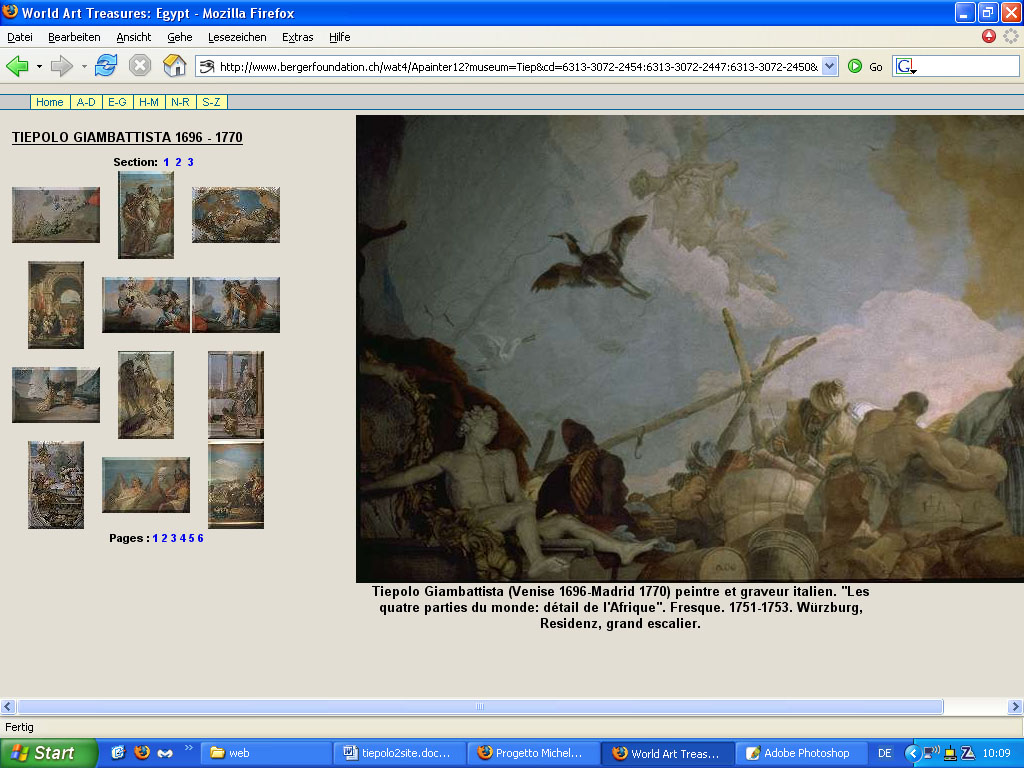Title of Product:
Tiepolo, bergerfoundation
Country:
 Italy
Italy
Century: 1700 - The 18th Century
Topic: Tiepolo
Image of the product:

Name of Author(s): Author and contributors
• Author and documentation Jacques-Edouard Berger
• The project is directed by:
Professeur René Berger/ Jacques-Edouard BERGER FOUNDATION
• Translation French-English: Peter S. Jordan, Los Angeles and Margue
Name of Producer: Fondation J.-E. Berger
Language/s of Product: French-English
Target Group: Secondary school; University.
Website last update: April 2008
Overall Evaluation: excellent
Objectives & Structure:
The principal purpose of World Art Treasures is to promulgate the discovery and love of art. Thanks to the 100,000 slides belonging to the Jacques-Edouard Berger Foundation, all of them devoted to art, and including the main civilizations, such as Egypt, China, Japan, India, Europe, its purpose is to offer a different approach to art through Internet. Taking advantage of the specificity of a multidimensional and multilevel network, it is an attempt to shed new light on art and a new way of contemplating it.
In contrast to the usual way of setting up a small or huge data banks according to a documentary or historical perspective, our ambition is to build a specific approach for each itinerary, each time taking into account and emphasizing a specific and original trait in order not only to provide information, but to give birth to give birth to a truly new experience thanks to cutting-edge technology.
Description of contents:
These first shared treasures soon sprouted a whole series of offshoots: Roman Portraits from Egypt n January 1995, Sandro Botticelli in May 1995, A Shared Vision in December 1995, Enchanted Renaissance Gardens n March 1996, Vermeer n June 1996, Angko in May 1997, Dizzying Grandeur of Rococo in May 1997, Georges de La Tour in September 1997, Borobudur n December 1997, Caravaggio in March 1998 - programs that are already past history in the light of all the subsequent advances in technology. Surprisingly and endearingly, right from the start this innovative undertaking enjoyed the warmhearted and very diversified collaboration of a wide circle of friends. It was they who, among other things, saw to the digitizing of several thousand slides, the gradual addition of legends, and the researching and verification of all the sources. More recently, in view of the progress in the software realm, they have also seen to it that Jacques-Edouard's lectures could appear on the Internet, treating viewers to his brilliant commentary viva voce on various subjects of his choice and many of his travels. Not to mention, furthermore, the generous and dedicated work accomplished by the members of the Foundation Committee, including the much appreciated contributions of several temporary assistants. All of which brings us to the site as it exists today: "FONDATION JACQUES-EDOUARD BERGER: World Art Treasures"
In total contrast to Baroque, the Rococo style dances, plays itself out completely. Its lilting tones sing with the passion of the castrati, glorifying God with the fervor of an entire era.
This very fervor comes through in the work of the Venetian painter Jean-Baptiste Tiepolo, for instance in his "La Montée au Calvaire" (The Way to Calvary), one of the rare episodes of the Christian epic he chose to stage. What we see here goes counter to all that precedes it: gone from the scene are the dark-light essentiality, immobilism, silence and, above all, vital confidentiality between the viewer and the work. This work lives autonomously, exalting its own prowess, dancing and singing to its own glory.
Clearly, all the lines of this work progress upwards, towards the heights of Golgotha. The colors too - all the reds, blues, whites, golds, yellows, flesh colors in various shades - all progress upwards. The artist obviously enjoyed playing with space, producing something that is basically theatrical. In its contrast with the work of Caravaggio, Meylan, Guido Reni, van der Werff and Piazzetta, this painting serves as a masterful introduction to pictorial Rococo.
It also points the way to architecture: just as the Baroque paintings led us to the Il Gésu choir in Rome, so this painting by Tiepolo guides us to Rococo architecture, in particular as exemplified by Bavarian constructions. Here again, we will find ourselves far from the austere cult of the divine mystery. Instead, we will be confronted with works that translate a stylistic explosion accomplished with supreme mastery.
Evaluation and Comments:
Overall Evaluation: excellent
Clarity of structure, logical sequence of contents: excellent
Usability / easiness of navigation: excellent
The website is interesting / stimulating: excellent
Educational and learning value: excellent
Quality and relevancy of content: good
Compatibility of the content with the target group: good
Suitability and quality of graphic interface: good
Degree and quality of interaction: good
Exploitation of the electronic potential: good
Quality of the evaluation tools: good
Possibility of printing/saving material or tests: good
Description of how the website can be used with the students::
Website can be use like an autonomous learning
Comments about this product

 Italy
Italy